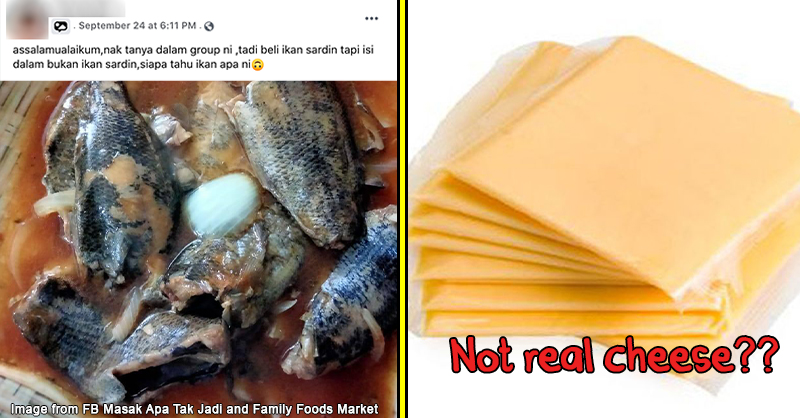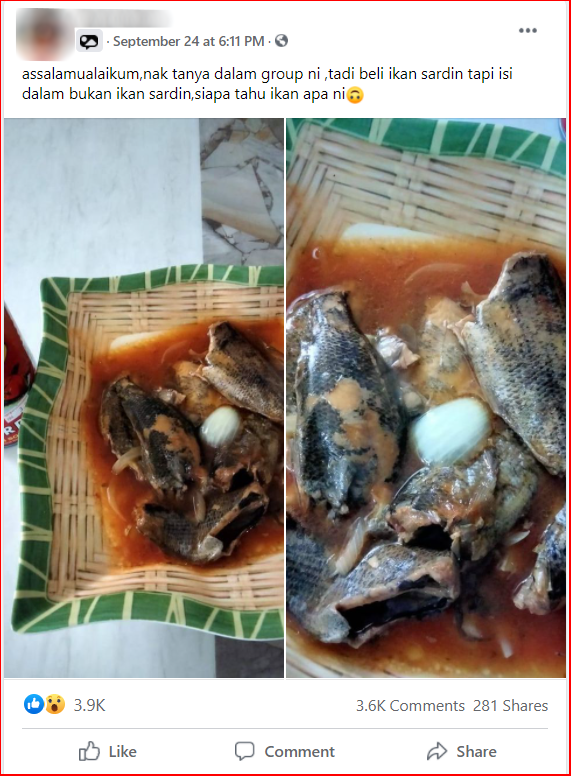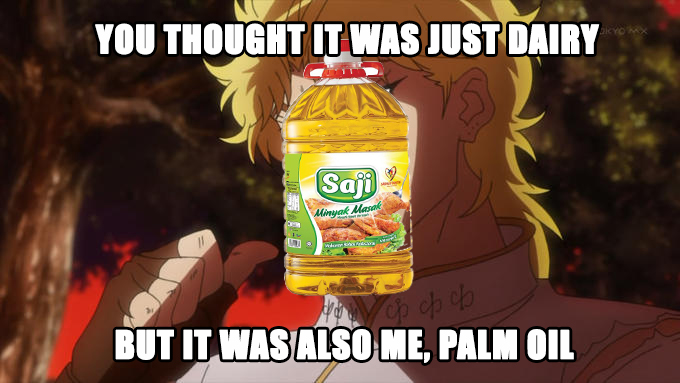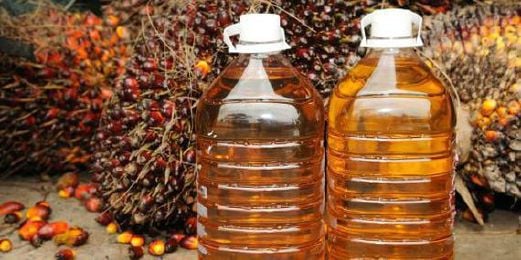6 foods Malaysians eat that aren’t what you think they are

- 1.6KShares
- Facebook1.3K
- Twitter29
- LinkedIn26
- Email29
- WhatsApp170
So recently, we saw this post on the FB group Masak Apa Tak Jadi Hari Ni? because the poster thought there was something fishy about their “sardines”.

Because we kepoh, we also started to check la, eh what do sardines actually look like? And what we found out was that the name sardines doesn’t refer to one specific fish – it actually refers to a few types of fishes.
In fact, nobody in the office knew that fact so then we started to wonder, what else do we eat isn’t what we thought they were? So after thinking back about our diet and reading through some government regulations, we’ve found 6 of these foods that aren’t what you think they are. Just beware that once you know this, you can’t un-know it.
For this list, let’s start with the one that started it, which is that…
1. Sardines actually refer to 21 types of fishes

Unless you’re a fisherman or rajin go to the market, you’ve probably only seen sardines from cans, covered in tomato sauce. But as we mentioned before, sardines isn’t a type of fish; rather, it refers to a few different types of fishes, and it’s not just the different brands you find on a sardine can.
Sardines is used to refer to small, oily fishes from the family Clupedia. Legend has it that the name came from the island of Sardinia, cause these types of fishes used to be plentiful there. But as with most words that have been used forever, it’s disputed cause no one can confirm if it’s true.
What the fishes exactly are depend on the region. FAO and WHO have listed 21 types of fishes that are classified as sardines, but in Malaysia it usually refers to ikan tamban. To make our lives more complicated, there are a few different type of tambans from the Clupedia family, namely:
- White Sardinella (Tamban Sisik Putih)
- Deepbody Sardinella (Tamban Sisik Pipih)
- Fringescale Sardinella (Tamban Sisik Tajam)

Sardines might be a technical definition, but in some states in Malaysia, it’s also used as bahasa pasar (geddit?) to refer to fishes that technically aren’t sardines. So for example, if you’re from Sabah you might just refer to ikan basung as sardines.
2. Your ice cream probably has palm oil inside it

In most western countries, for something to be classified as ice cream, it must contain at least 10 percent milk fat, and be made using only milk or milk products.
In Malaysia, we have the same requirements and if you don’t reach the 10 percent threshold, it has to be called something else like a “frozen dessert” or “ice confectionary”.
But our 10 percent isn’t strictly dairy, because based on our regulations, it can either be milk or vegetable oil or a mixture of both.
And you know what’s classified as vegetable oil? Palm oil.

We know what you’re thinking: “Got kelapa sawit in my ice cream???” Okay first, chill, cause it’s not like they just open a bottle of minyak sawit then drizzle it on your frozen dessert. They could be using sunflower oil instead. Ok jk that’s not how it works.
In case you’re wondering why there’s oil in your food, fat is actually nearly similar to oil as they both contain fatty acids, and it’s used to make your ice cream firm when it’s frozen. In fact, if you boil milk, you might just see a layer of oil floating to the top, which is actually one method to make skimmed milk.
But regardless of the proper name, we know no one’s gonna walk into a kedai runcit and say, “Bang, nak beli frozen dessert satu.”
3. The beef you’re eating is probably from a buffalo

Surprise, surprise. If you thought that the beef you’ve been eating all this time came from a cow, it might actually come from a buffalo instead.
If you didn’t know about this, You might think that it’s due to the halal meat cartel scandal where people have wrongly labeled buffalo meat as cow meat.
But it’s not – we’ve always been importing buffalo meat, with 70% of it coming from India, and the rest from Australia, Bangladesh, and Pakistan.
This is because of our local demand for beef. Malaysia only produces 52,000 tons of beef annually, but the national demand is nearly 4 times that, so we had to make the difference by importing it.
Malaysia can’t produce that much meat for several reasons, such as not having enough grazing land and the profits aren’t that much due to the control of price. And in a weird way, importing beef is much cheaper than making our own.
But don’t feel bad if you can’t tell them apart, because even in India, where 70% of our beef is imported from, they also have issues in differentiating it at times.
4. Wasabi you’re eating is probably horseradish

When you’re eating sushi and then cicah it in your soy sauce and wasabi, you might feel that it’s 100% authentic Nihongo ingredients. But actually, it might not even be wasabi.
Nani?
It’s true! Watashi not lying to anata. Omae wa mou probably eating horseradish.
Technically la, wasabi is a type of horseradish aka Japanese horseradish, and is the same family as cabbage, broccoli and mustard. But it tastes slightly different.

See, they both have that cold pedas that masuk hidung, which is caused by something called isothiocyanates. But wasabi has that in abundance, which also gives it a more complex flavour (watashi cannot confirm because marhaen and never ate real wasabi).
But in case you feel like a pleb for only ever eating horseradish, don’t because some Japanese people probably haven’t tried it either. It’s really hard to grow making it quite expensive that it’s called “green gold”, and most of it would be snapped by wholesalers.
To grow this cerewet plant, you need crystal clear water and for the temperature to stay between 10-15 degree the whole year round. In some places it’s grown using mountain water filtered by layers of pebbles and sand, which means this Japanese horseradish has a better quality of life than watashi-wa.
5. Your potato chips are probably made from powder

As you eat your potato chips from the tube, you might think, “Hmm, I wonder if this company sells tennis balls too”.
But after that, you might think, “Wow, the shape is so uniform – how do they manage to get the potato chips to have such similar sizes and just right for the tube?”
Well, the secret is that they’re not made from sliced potatoes. Rather, they’re made from a mixture of dried potato flakes which are ground into a powder then mixed with oil, water, and a few different starches and flour, like cornstarch and rice flour, to create a goopy batter. This batter is then cut into slices and cooked on a saddle mold to get that uniform stackable shape we have.
In case that’s hard to visualise, there’s actually a video showing how it’s done here:
But they are still technically made from potatoes, even if it’s less than 50% of the content. But because they’re not made from potato slices, they’re only allowed to be called potato crisps instead of potato chips.
Despite it just being a crisp, there was actually a lot of engineering that went into designing it. The horse saddle shape that it has is called a hyperbolic paraboloid. It’s apparently a very sturdy shape that could withstand strong pressure, which allows the crisps to be stacked without cracking. This is also why architects love the shape and some buildings such as the London Velodrome share the same look, though it’s unlikely they’ll stack one building on top of another.

Fun fact: there are only 5 Pringles factories worldwide, and one of them is in Johor.
6. The sliced cheese you’re eating isn’t actually “cheese”

Cheese slices, the square ones that your mum will letak on your roti can’t actually be called cheese.
For something to be called “cheese”, there are very strict regulations on it. Basically they can only be made from milk or milk products such as cream, and you’re only allowed to add bacteria culture or mould which will ferment it and make it into a solid. You also can’t melt or process it – basically, you have to add culture to the milk then leave it alone.
Anything else, such as cheese slices can only be called processed cheese. They aren’t 100% cheese, and may only contain roughly 50% cheese. Don’t worry, they are made from real cheese, but they are mixed with other stuff such as salt, preservatives, and other artificial ingredients.

But even processed cheese requires it to have at least 51% dairy content in them. Anything less and they’ll have to be called “cheese food products” so it’s clear that it’s a little bit sus.
Shower thought: So does that mean the milk we left in the fridge for weeks that became solid might technically be real cheese? Reply in comments with the answer if you’re a food regulator.
This information might already be on the label itself
Some of you might think that you should “do your own research” on how to identify what’s in your food, and follow advice from food hack channels on Youtube. But this type of misinformation has already been debunked a few times.
The easiest way is to just read the ingredients on the label because the manufacturers are required by law to list them on the packaging itself.
And now that you know all this, sorry for potentially ruining your future meals.
- 1.6KShares
- Facebook1.3K
- Twitter29
- LinkedIn26
- Email29
- WhatsApp170



